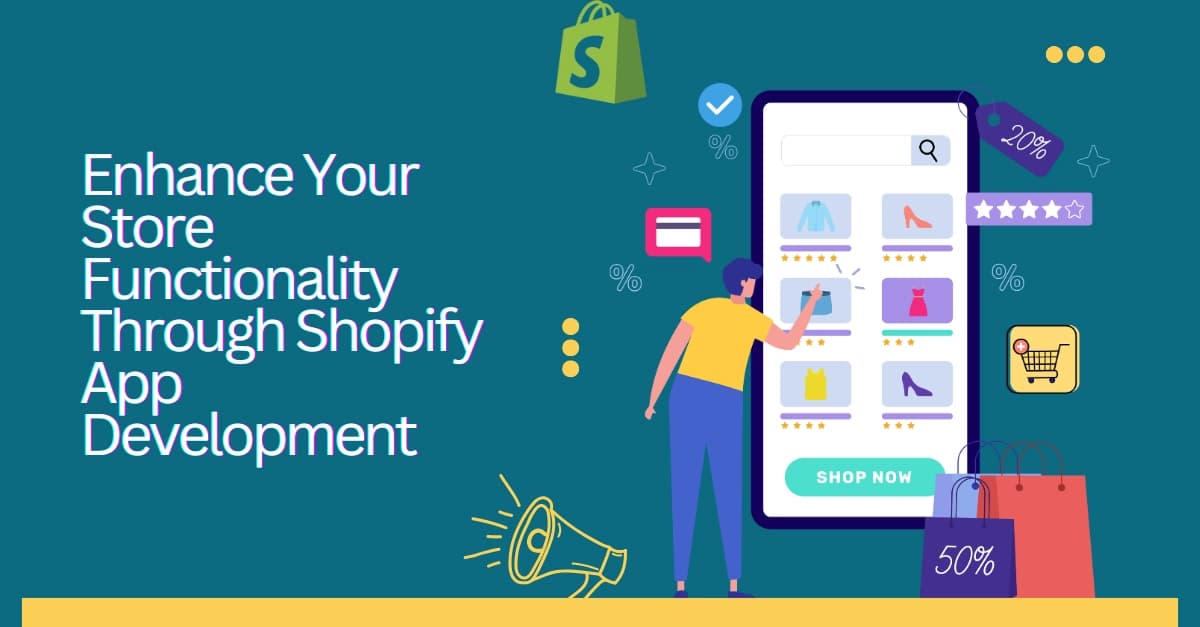Shopify App Development: Extending Your Store’s Functionality
Discover how Shopify App Development helps businesses extend store functionality, automate workflows, and create personalized shopping experiences. Learn how custom apps and integrations can transform your Shopify store into a scalable, high-performance ecommerce platform.
![[object Object] profile picture](/_next/image?url=%2Fteam-placeholder.webp&w=128&q=75)
Manjeet Singh
- Oct 30, 2025

In today’s fast-paced ecommerce landscape, businesses can’t thrive on generic store setups alone. Every growing brand eventually needs to push Shopify beyond its default capabilities — integrating unique business logic, automation, and customer experiences that match its operational complexity. That’s where Shopify App Development becomes the real growth engine.
Through custom apps, integrations, and extensions, merchants can transform a basic store into a scalable, intelligent commerce platform. In this article, I’ll share first-hand insights into Shopify custom app development, how apps extend Shopify store functionality, and what best practices developers and merchants should follow — all grounded in Shopify’s official guidelines and real-world experience.
Understanding Shopify App Development
At its core, Shopify App Development allows you to add new features and automate processes that aren’t available out of the box. Apps connect to Shopify’s ecosystem via APIs, enabling everything from advanced analytics and inventory management to subscription logic and AI-powered personalization.
According to the Shopify Developer Documentation, apps can “extend Shopify’s core capabilities, integrate external services, and enhance the merchant and customer experience.” The platform provides both REST and GraphQL APIs, webhooks, and development frameworks like Polaris and App Bridge for embedded experiences.
In essence, Shopify apps are the building blocks of modern ecommerce — and when done right, they become a competitive advantage rather than just add-ons.
Why Businesses Need Custom Shopify Apps
Every merchant’s needs evolve differently. You might require complex discount logic, custom reporting, warehouse routing, or an integration with your CRM or ERP. While public apps on the Shopify App Store can help, they’re built for broad use cases — not your specific operations.
That’s where Shopify custom app development comes in. A tailor-made app gives you the freedom to create what your store truly needs. As explained in Shopify’s Partner Blog on custom apps, businesses often develop custom apps to “bridge gaps between Shopify and third-party tools, automate manual work, or provide unique buying experiences.”
Some examples of custom app use cases include:
-
Synchronizing Shopify orders with a warehouse or ERP.
-
Managing custom product bundles or subscription cycles.
-
Integrating customer loyalty systems and referral programs.
-
Creating dynamic pricing engines or inventory forecasting.
In short, custom apps empower your store to operate like enterprise-grade software — without leaving the Shopify environment.
The Shopify App Ecosystem: Public vs Private Apps
There are two primary types of apps:
-
Public apps — distributed via the Shopify App Store, available to multiple merchants.
-
Custom apps — built for a single store or a private group of stores with unique requirements.
Both types rely on the Shopify API development ecosystem, which provides endpoints for products, orders, customers, and fulfilment.
For example, a logistics company may create a private Shopify app that automatically routes shipments to different warehouses using Admin APIs, while a SaaS company could release a public Shopify app integrating with their CRM to thousands of merchants.
The official Shopify API reference notes that apps can “read, write, and modify store data securely,” provided they follow OAuth authentication and permission scopes — ensuring that integrations remain compliant and safe.
Extending Shopify Store Functionality
1. Custom Integrations
Shopify integrations connect your store to the tools that run your business — from payment processors and shipping carriers to marketing platforms and CRMs. A well-designed integration streamlines data flow and reduces human error. For instance, integrating a CRM like HubSpot or Salesforce with Shopify allows your sales team to see real-time customer data and purchase history. This is one of the most common use cases of Shopify API development, and Shopify’s REST and GraphQL APIs make it easier than ever to sync customer and order data.
According to TechCrunch’s analysis of the Shopify ecosystem, merchants using advanced integrations see up to 30% higher automation efficiency and improved retention because “custom integrations allow real-time personalization and unified data insights.”
2. Enhanced User Experience
Shopify’s default features work for many stores, but successful brands go further — crafting experiences unique to their customers. This could mean building a custom subscription app, a personalized product builder, or a loyalty dashboard. Shopify plugins and extensions enable such features while keeping the native feel of the admin interface. Using frameworks like Shopify Polaris, developers can design UIs that integrate seamlessly with the Shopify dashboard, ensuring consistency and usability.
By investing in eCommerce app development, businesses not only elevate their brand experience but also empower internal teams with tools that match their workflows.
3. Process Automation
Automation is one of the most valuable benefits of Shopify custom app development. Apps can listen to store events through webhooks — for example, automatically emailing suppliers when stock is low, or tagging high-value customers for priority support.
These automations replace manual tasks, improving accuracy and freeing up time for growth-oriented activities. Shopify’s own Automation API documentation provides a blueprint for integrating Shopify Flow and event-based triggers to achieve these efficiencies.
Key Components of a Shopify App
1. APIs and Data Access
All apps interact with Shopify data through APIs. Developers must use secure authentication methods (OAuth 2.0), request the correct permissions (scopes), and stay aligned with quarterly API version updates.
2. Embedded App Design
Modern apps live inside the Shopify Admin via App Bridge and Polaris UI — providing a cohesive experience. This reduces merchant friction since they can manage everything in one dashboard.
3. Webhooks and Events
Shopify apps can subscribe to webhooks that notify them of store events like order creation, inventory updates, or refund processing. This event-driven design underpins most real-time automation.
4. Security and Compliance
Shopify enforces strict data policies, requiring encryption in transit and at rest, along with data deletion on uninstallation. Following these ensures merchant trust — a pillar of Shopify Development services.
The Shopify App Development Lifecycle
Creating a robust app requires clear planning, technical discipline, and continuous improvement.
Discovery and Requirements Gathering
Identify pain points, desired automations, and necessary integrations. Define measurable outcomes — speed, cost reduction, or new capabilities.
Architecture and Tech Stack
Choose a backend (Node.js, Ruby on Rails, or Python) and a frontend (React with Shopify Polaris). Decide whether it’s embedded or standalone, and where it will be hosted (Heroku, AWS, or Vercel).
Development and API Setup
Configure the Shopify CLI, set up authentication, create a database schema, and implement API endpoints.
Testing and Quality Assurance
Use test stores for development. Follow Shopify’s app performance best practices to ensure your app loads quickly and efficiently.
Deployment and Maintenance
Deploy the app to production. Regularly monitor logs, track API version deprecations, and schedule maintenance releases.
This systematic approach aligns with how experienced Shopify partners deliver secure, scalable, and high-performing apps.
Real-World Example: Building a Custom Inventory App
A client managing multiple warehouses struggled with inventory synchronization across channels. Using Shopify API development, our team built a private app that automatically:
-
Synced real-time inventory levels with ERP systems.
-
Allocated stock dynamically based on demand.
-
Sent webhook alerts for low-stock SKUs.
The result was a 60% reduction in out-of-stock errors and faster order fulfillment — directly improving ROI.
These real-world gains demonstrate how Shopify custom app development translates into tangible business growth.
Emerging Trends in Shopify App Development
The Shopify ecosystem evolves quickly. Key trends shaping eCommerce app development include:
-
Headless and composable architectures: More merchants are using Shopify APIs to power React, Vue, or Next.js frontends for speed and flexibility.
-
AI-driven personalization: Apps that recommend products or optimize pricing through AI APIs.
-
Omnichannel integration: Unified customer data across web, social, and in-store channels.
-
Subscription and retention apps: Custom-built solutions for recurring commerce and loyalty.
As Forbes Technology Council notes, “The future of ecommerce isn’t about isolated storefronts — it’s about connected ecosystems that respond intelligently to customer behaviour.” Shopify apps are the foundation of that future.
Best Practices for Scalable Shopify App Development
-
Build for performance: Optimize database queries, compress assets, and use lazy loading.
-
Follow Shopify’s design guidelines: Use Polaris components for admin consistency.
-
Plan for multi-store scalability: Design your app to handle multiple merchants and regions.
-
Ensure data privacy: Follow Shopify’s GDPR and data deletion policies.
-
Stay ahead of API version changes: Shopify deprecates older APIs quarterly — maintain forward compatibility.
These practices aren’t optional — they define whether your app becomes a reliable business asset or a liability.
Common Challenges and How to Overcome Them
-
API Rate Limits: Use batch calls and retry logic to avoid throttling.
-
Authentication Complexity: Implement OAuth securely with refresh tokens.
-
Webhook Reliability: Store webhook data in queues for fault tolerance.
-
App Store Approval: For public apps, follow Shopify’s publishing guidelines and merchant data protection policies.
-
Maintenance Burden: Automate testing and CI/CD pipelines for ongoing stability.
These challenges are manageable when approached strategically — and they separate professional Shopify Development services from amateur efforts.
Conclusion: The Merchant’s Perspective
For merchants, apps are no longer optional — they’re essential. Whether automating back-office tasks, connecting data systems, or crafting better customer journeys, Shopify App Development unlocks the next stage of ecommerce maturity.
From a user’s perspective, a well-built app isn’t something they “see” — they experience it through faster load times, smoother checkouts, and personalized journeys. For business owners, it means efficiency, control, and scalability. As Shopify continues to evolve, your store’s competitive advantage will depend on how intelligently you extend its functionality. Investing in custom Shopify app development today lays the foundation for an agile, integrated commerce experience tomorrow.
Latest Posts

Integrating AI into Web Development: Frameworks and Future Trends
Manjeet Singh
Nov 12, 2025

NestJS: The Backbone of Modern Enterprise Applications
Manjeet Singh
Nov 6, 2025

How to Build a Secure, Serverless Website Using Jamstack Architecture
Manjeet Singh
Oct 24, 2025

Why Developer Expertise Matters More Than Ever in the AI Era
Abhishek Bhardwaj
Oct 18, 2025